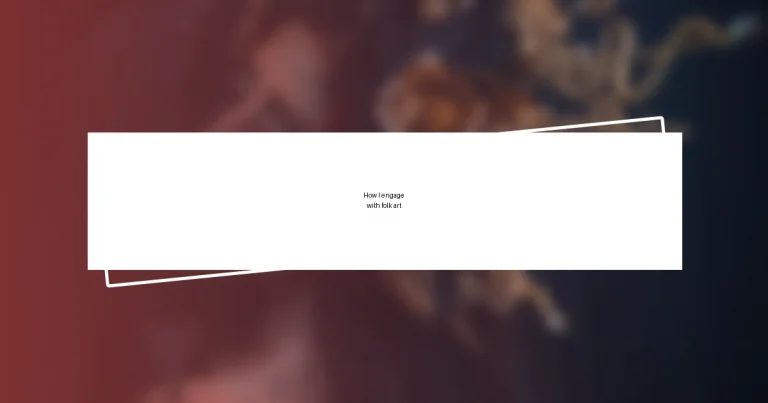Key takeaways:
- Folk art embodies cultural values and shared experiences, connecting individuals to their roots.
- Engaging with local artists and participating in workshops enhances appreciation and fosters community collaboration.
- Exploring various folk art forms reveals universal themes and the impermanence of cultural expressions.

Understanding folk art significance
Folk art holds a mirror to the cultural values and everyday lives of communities. I remember visiting a local craft fair where each piece told a story that echoed the history and traditions of the artisans. It struck me how profoundly art can carry the emotional weight of shared experiences across generations—have you ever felt that connection when viewing something handmade?
What really resonates with me about folk art is its ability to transcend the complexities of modern life. During a visit to a rural town, I stumbled upon a vibrant quilt that depicted local folklore. The colors and patterns were not just visually appealing; they wrapped me in the warmth of the stories behind them. Have you ever perceived art as a way to connect with your roots?
Moreover, folk art fosters a sense of community, bringing people together through shared beliefs and heritage. As I participated in a community pottery workshop, I felt an undeniable spirit of collaboration. Each person added their personal touch, creating something greater than individual contributions. Isn’t it fascinating to think about how art can weave a tapestry of connections among diverse people?

Exploring different folk art forms
Exploring various folk art forms can truly be an eye-opening journey. For instance, I recently explored the intricate art of Mexican papel picado, which is a form of decorative paper craft. Watching artisans create these delicate, finely cut designs made me appreciate the craftsmanship involved. Each piece seemed to tell a story—do you find that certain art forms make you feel more connected to a culture than others?
During a visit to a local ethnographic museum, I was captivated by the vibrant hues of Indian rangoli, made from colored powders and often designed for festivals. The temporary nature of this art intrigues me; it highlights the beauty of impermanence in life. Have you ever witnessed art that disappears, leaving only memories behind? It’s a poignant reminder of how cultures express joy and celebration through their artistic traditions.
Comparing folk art forms across cultures also illuminates shared human experiences. I remember looking at a display of African masks alongside Native American totems, and I was struck by their similar functions in storytelling and spiritual expression. It emphasized how diverse cultures use art to convey universal themes. Isn’t it fascinating how, despite different mediums, we find common threads in the human experience?
| Folk Art Form | Key Characteristics |
|---|---|
| Papel Picado | Delicate, intricately cut paper that celebrates festivals |
| Rangoli | Colorful patterns made with powders, often temporary |
| African Masks | Carved wood, often used in ceremonial contexts |
| Native American Totems | Wood sculptures that tell stories of heritage and spirituality |

Connecting with local artists
Connecting with local artists enriches my appreciation for folk art in ways I didn’t initially anticipate. For instance, I once attended a small exhibit featuring local painters. I found myself engrossed in a conversation with an artist whose work depicted the landscape of our community. As we chatted, I learned how personal experiences influenced their creations, and I felt a deeper connection to both the art and the artist. It’s remarkable how these interactions can breathe life into a piece that might have otherwise felt distant.
- Joining local art groups can foster these connections.
- Attend workshops and events to engage directly with artists.
- Visiting open studios allows for intimate exchanges about their creative process.
- Follow artists on social media to stay updated on their projects.
- Volunteer at local art initiatives to immerse in the community.
In my experience, these avenues not only cultivate relationships but also transform the way I perceive and value folk art.

Participating in folk art workshops
Participating in folk art workshops is a transformative experience. I remember attending a pottery class where the instructor shared stories about the cultural significance of each piece we created. As I shaped the clay, I could feel the connection to generations of artisans before me—like a thread weaving me into a larger narrative. Have you ever felt history resonate beneath your fingertips while you create?
In another workshop focused on textile arts, the vibrant colors and patterns of the fabrics sparked an unexpected joy in me. Collaborating with others while learning traditional techniques felt like a celebration of creativity. The laughter and camaraderie in the room reminded me that art is not just an individual pursuit; it’s a shared experience that fosters community. Isn’t it remarkable how the act of making art can forge bonds among strangers?
Each workshop I’ve attended has not only honed my skills but also deepened my understanding of different cultural contexts. I still recall a folk painting class where we explored symbolism in patterns representative of local folklore. This immersive learning opened my eyes to the stories behind each brushstroke. It’s moments like these that make me ponder: how can storytelling through art bridge gaps between cultures and strengthen our understanding of one another?














